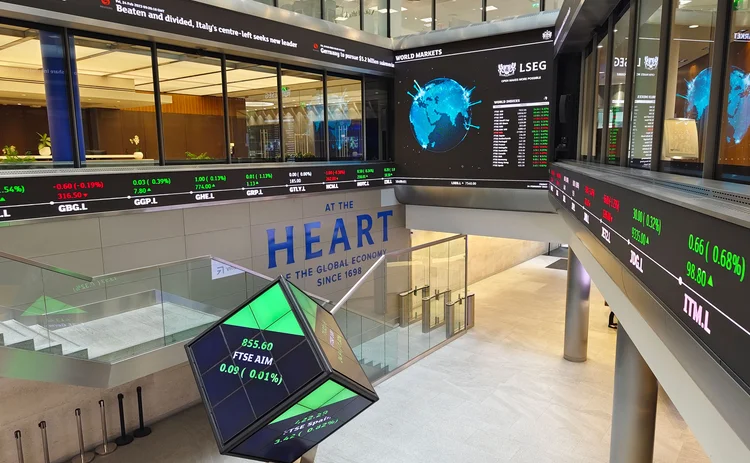
Clearing house of the year: LCH
Risk Awards 2025: LCH outshines rivals in its commitment to innovation and co-operation with clearing members

In central clearing, projects can take time to bear fruit, as clearing members and clients have to make decisions about changing their existing set-up to take advantage of new services offered.
In the past year, LCH has benefitted from initiatives launched previously, and the results have made the central counterparty (CCP) this year’s winner in the clearing house category.
Top of the list is the performance of CDSClear in Paris, after the efforts it made in 2023 to pick up clients following the closure of Ice Clear Credit’s European business. For Ice Clear Credit’s former clients, the choice was always between reopening positions on Ice’s US-based CCP or turning to LCH in order to continue clearing in Europe.
Market participants believe LCH’s offering has proven “better” than the service it replaced. That most likely explains why CDSClear seems to have scooped up a significant part of the former Ice Clear Credit franchise. In the first half of 2024, CDSClear handled €426 billion ($444 billion) in client notional volume, up 88% compared with the same period in 2023.
That performance has been boosted by activity from new members including Santander and the European and international arms of Goldman Sachs. LCH also expanded the number of products that it clears compared with the original Ice offering, including adding new single-name credit default swaps. There are now 217 client entities live across 1,753 accounts and 19 clearing brokers.
“We maintained the momentum since migration of the volume from Ice,” says Marcus Robinson, who was appointed head of CDSClear and DigitalAssetClear in June 2024. He adds that LCH expanded the number of products and indexes, and improved dealer workflow by upgrading trade compression services.
It is an incredibly interesting time to lead a rates clearing service. The market keeps growing year-on-year, but it’s a complex market that continues to evolve
Susi de Verdelon, LCH
One asset manager suggests LCH is also preferred by clients who want access to segregated account clearing, because Ice Clear Credit in the US uses the omnibus account structure.
The advent of the EU’s revised European Market Infrastructure Regulation – known as Emir 3.0 – could provide a further tailwind for CDSClear, which is part of LCH’s French entity LCH SA. With pressure on EU asset managers to clear their index credit default swaps onshore, fixed income funds that hedge using euro-denominated CDS instruments are likely to prefer the EU-domiciled CCP over the US-based Ice Clear Credit.
CDSClear has plans to take on the US next, as it is gearing up to attract more futures commission merchants (FCMs) to clear US credit business. The new offering has so far attracted two FCMs during 2024 – BNP Paribas and Morgan Stanley. Robinson says they are expecting more to join in the new year, as firms want to see competition with Ice in the credit space in the US.
SwapClear stays on track
LCH’s interest rate swap clearing business is already the market leader in Europe, but that didn’t stop it enjoying another bumper year of growth. Volumes on SwapClear reached a record of $779 trillion of notional cleared transactions in the first half of 2024, up 15% compared with the same period in 2023.
“It is an incredibly interesting time to lead a rates clearing service. The market keeps growing year-on-year, but it’s a complex market that continues to evolve. It’s been a very special year for SwapClear because it navigated that complexity really well,” says Susi de Verdelon, group head of SwapClear and listed rates.

Clearing members praised the pricing for SwapClear’s services, its constructive approach to margin transparency, and its reliable handling of any margin shortfalls, including good information flows to its users.
“What the clearing members really want is to get the basics right,” says an executive at one clearing member.
Unlike CDSClear, SwapClear is based in London, and that means Emir 3.0 could force EU firms to consider relocating their business. LCH estimates that roughly 9% of the volume that touches on its euro swaps universe could be affected by the regulation as it relates to EU clients.
However, the final wording of Emir 3.0 was less punitive than many had feared. Both clearing members and end-clients say they expect some business to drift out of SwapClear and into the EU, but nowhere near enough to undermine the strength of the overall business model.
There is certainly little sign of weakness so far. In the first half of 2024, euro interest rate swap activity accounted for 39% of LCH SwapClear’s total notional, up from 36% in the same period of 2023.
Collateral appeal
One asset management executive explains that the key advantage LCH holds over EU rivals is the depth of liquidity it can offer in currencies other than euros or dollars. This means any firm trading swaps across multiple currencies is unlikely to migrate significant volumes out of LCH.
“It makes no sense because they would have to break up their netting sets and it would increase margin,” says the asset management executive.
A further appeal of using LCH is its proactive approach to developing new tools for collateral management, which continues to be an area of focus for banks, asset managers and asset owners. LCH’s custodial segregation offering for non-cash collateral was originally launched in 2017. The non-cash collateral is delivered directly to LCH via a triparty arrangement.
For asset managers looking to safeguard their fiduciary duties, this structure allows them to retain beneficial title to the securities posted and remove the transit risk associated with collateral delivery. The service has now received a significant boost with the addition of HSBC and BNP Paribas to the roster of banks offering custodial segregation accounts.
“These projects aren’t conceived and delivered in a couple of months. But 2024 is the year when they came to bear,” says de Verdelon.
SwapClear also continues to broaden its eligible non-cash collateral, with plans to include Danish covered bonds in the coming months likely to be welcomed by Scandinavian pension funds in particular.
Smart clearing
Unlike the credit default and interest rate swaps markets, there is no clearing obligation for foreign exchange in Europe. That means firms must make decisions on whether to clear based on an economic cost-benefit analysis that sets higher margin and liquidity requirements against potentially lower capital requirements.

In November 2023, LCH’s ForexClear partnered with another London Stock Exchange Group subsidiary – compression specialist Quantile – to deliver a new smart clearing solution. Rather than clearing all trades, this allows banks to clear parts of their books selectively, arriving at a “sweet spot” where they can generate capital savings without blowing up margins, explains Andrew Batchelor, head of LCH ForexClear.
There is every sign the innovation has made ForexClear a more attractive proposition, with five new clearing members signing up over the past year including Commerzbank and Wells Fargo. The initial margin at LCH’s ForexClear surged 32% to $10.7 billion at the end of the second quarter of 2024, marking a new record amount.
New kid on the block
One of the boldest initiatives over the past 12 months was the launch of clearing for the US start-up exchange FMX, which offers trading in three-month SOFR futures. So far, five FCMs are set up to operate on the platform, with market participants suggesting a slow start. However, LCH remains optimistic and ambitious for the project, with FMX planning to launch US Treasury futures clearing imminently.
“Our plan is to continue to add clearing members and to roll out Treasury futures next year,” de Verdelon comments.
The combination of FMX and LCH represents a head-on challenge to the entrenched incumbent CME Group. And it comes at a crucial time, when the Securities and Exchange Commission’s Treasuries clearing mandate is prompting market participants to think about how to increase their available clearing routes.
“It’s another demonstration of the commitment from LCH to bring further choice to the market,” says de Verdelon.
Another key geographic priority for LCH is in Asia, where SwapClear has picked up additional volume and members in the past year. As in Europe, the clearing house is aiming to appeal to the market by extending the breadth of eligible collateral, which will include euro- and dollar-denominated Chinese government bonds in 2025.
Even though this initiative is primarily intended for Asian firms, if collateral meets LCH internal risk management requirements, it will be eligible for all the CCP’s businesses. Consequently, one source describes this as a potential “game changer” when it is introduced.
Only users who have a paid subscription or are part of a corporate subscription are able to print or copy content.
To access these options, along with all other subscription benefits, please contact info@risk.net or view our subscription options here: http://subscriptions.risk.net/subscribe
You are currently unable to print this content. Please contact info@risk.net to find out more.
You are currently unable to copy this content. Please contact info@risk.net to find out more.
Copyright Infopro Digital Limited. All rights reserved.
As outlined in our terms and conditions, https://www.infopro-digital.com/terms-and-conditions/subscriptions/ (point 2.4), printing is limited to a single copy.
If you would like to purchase additional rights please email info@risk.net
Copyright Infopro Digital Limited. All rights reserved.
You may share this content using our article tools. As outlined in our terms and conditions, https://www.infopro-digital.com/terms-and-conditions/subscriptions/ (clause 2.4), an Authorised User may only make one copy of the materials for their own personal use. You must also comply with the restrictions in clause 2.5.
If you would like to purchase additional rights please email info@risk.net
More on Awards
Best use of machine learning/AI: CompatibL
CompatibL’s groundbreaking use of LLMs for automated trade entry earned the Best use of machine learning/AI award at the 2025 Risk Markets Technology Awards, redefining speed and reliability in what-if analytics
Markets Technology Awards 2025 winners’ review
Vendors jockeying for position in this year’s MTAs, as banks and regulators take aim at counterparty blind spots
Equity derivatives house of the year: Bank of America
Risk Awards 2025: Bank gains plaudits – and profits – with enhanced product range, including new variants of short-vol structures and equity dispersion
Law firm of the year: Linklaters
Risk Awards 2025: Law firm’s work helped buttress markets for credit derivatives, clearing and digital assets
Derivatives house of the year: UBS
Risk Awards 2025: Mega-merger expected to add $1 billion to markets revenues, via 30 integration projects
Interest rate derivatives house of the year: JP Morgan
Risk Awards 2025: Steepener hedges and Spire novations helped clients navigate shifting rates regime
Currency derivatives house of the year: UBS
Risk Awards 2025: Access to wealth management client base helped Swiss bank to recycle volatility and provide accurate pricing for a range of FX structures
Inflation derivatives house of the year: Natixis
Risk Awards 2025: French bank’s hedge fund push boosts its flow standing and creates repack risk offsets








